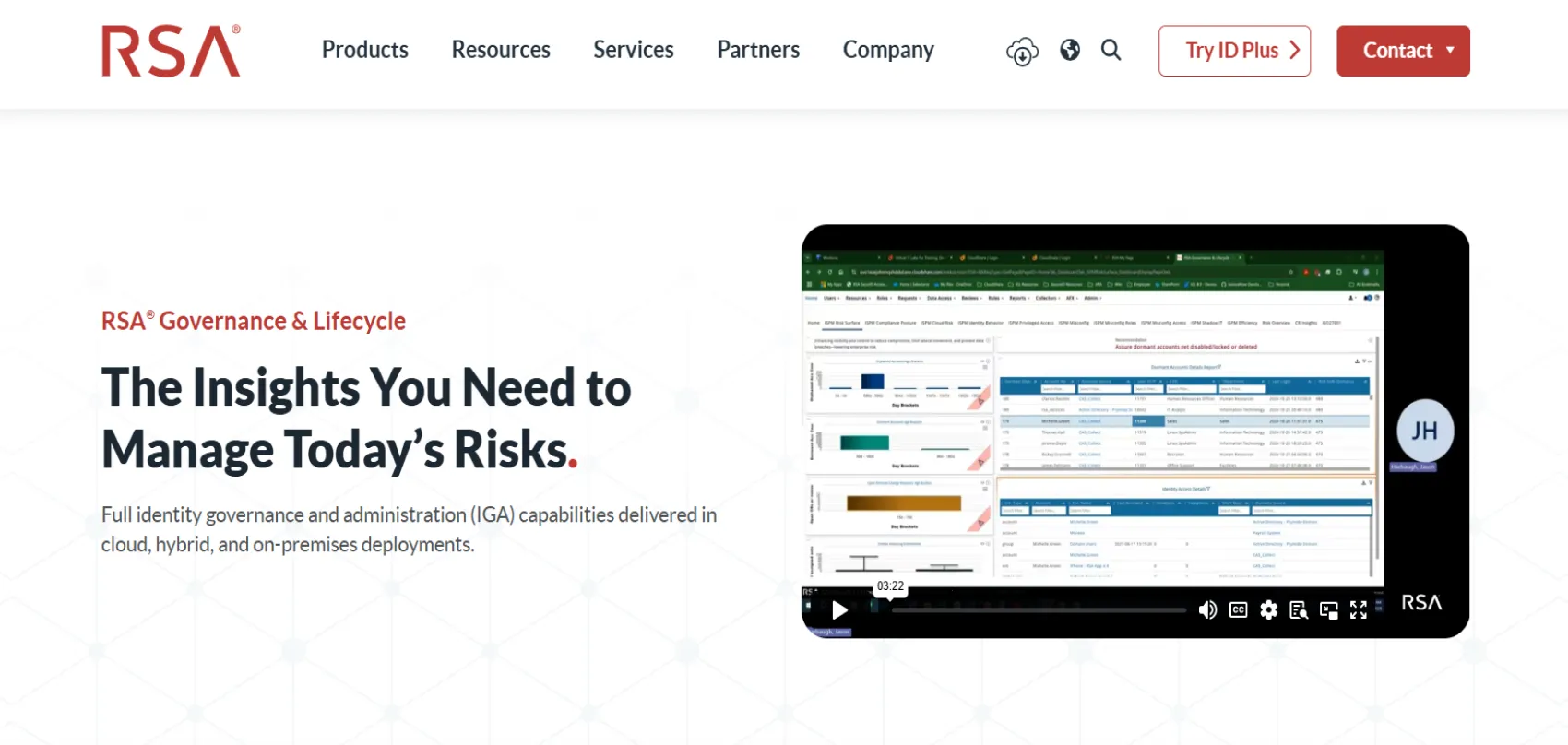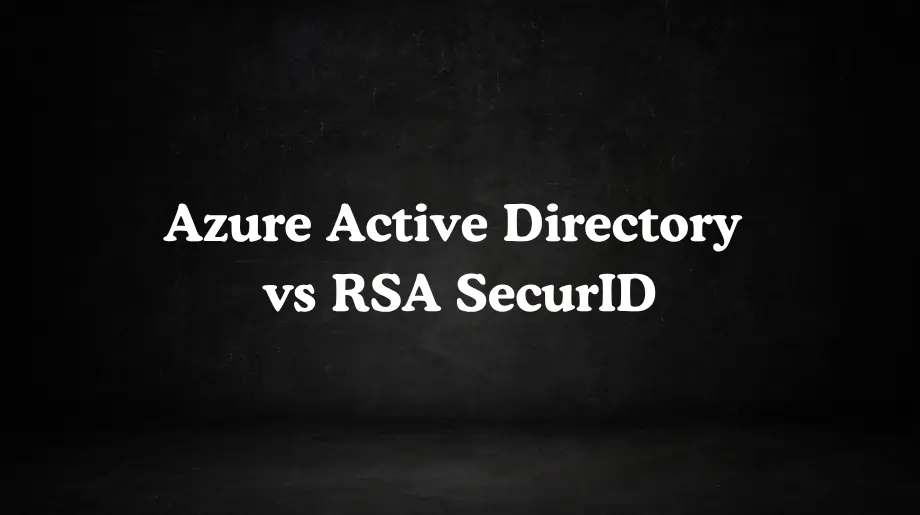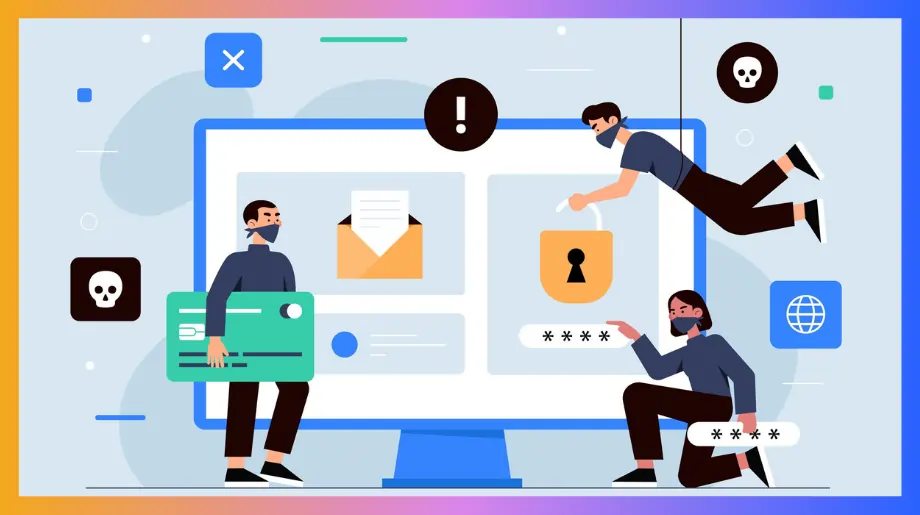As businesses move toward cloud services and remote work, secure and smooth access control has become essential.
Microsoft Azure Active Directory vs RSA SecurID both help meet this goal in different ways. Azure AD is a cloud based system that brings features like single sign on and multi factor authentication. It suits companies that are focused on digital change and modern workflows.
RSA SecurID uses strong token based authentication that fits best in high security areas such as banking and government systems. Knowing how these two platforms differ helps every organization protect its data and choose the right solution.
Azure Active Directory vs RSA SecurID: A Detailed Comparison
What is Microsoft Azure Active Directory?
Microsoft Azure Active Directory is a modern cloud identity system that helps organizations manage users and control access across all digital platforms with full security. Also called Microsoft Entra ID it gives employees one safe sign in for every business application.

It adds extra protection through mobile verification and security keys that keep every login secure and verified. The platform links on premise systems with cloud environments so every user keeps one trusted identity everywhere.
What is RSA SecureID?
RSA SecurID is an enterprise grade authentication platform that protects business data and systems through verified user access. It ensures that every individual signing in is genuine before entry is granted. The system operates through hardware tokens or mobile applications that generate time based login codes.

It can also apply push notifications or biometric checks to provide higher assurance. The platform integrates with a wide range of business environments and supports both on premise and cloud deployments.
Key Differences Microsoft Azure Active Directory vs RSA SecurID
Key Features of Microsoft Azure Active Directory vs. RSA SecurID
When comparing Microsoft Azure Active Directory vs RSA SecurID, understanding their core features helps reveal how each platform protects user identities and manages access.
Key Features of Microsoft Azure Active Directory
- Scalable & High Availability Architecture. Runs in Microsoft’s global cloud infrastructure with built-in redundancy and failover.
- App Proxy & Secure Remote Access. Lets users access internal applications securely without opening broad network tunnels.
- Automated Account Management. Uses automation to create, update and remove accounts as roles change.
- Hybrid Identity Support. It joins on premises Active Directory with cloud identity so users have one account for everything.
Key Features of RSA SecurID
- Legacy and VPN Compatibility. It connects easily with older systems and secure private networks.
- Local Control and Deployment. Authentication servers run within company systems for full data ownership.
- High Security for Regulated Use. RSA SecurID protects banking government and critical infrastructure systems.
- Centralized Management. IT teams can manage tokens users and authentication policies from one control console with full visibility.
Access Control & Authentication
Azure AD focuses on cloud-based smart rules and adaptive access, while RSA SecurID relies on strong token verification and on-premises control.
Access Control and Authentication in Microsoft Azure Active Directory
Azure AD uses cloud intelligence and layered security to make sign in smooth and safe. It adapts to modern work setups and supports both office and remote users.
- Single Sign On. Azure AD lets you sign in once and reach all business apps like Microsoft 365 or Salesforce without entering many passwords.
- Multi Factor Authentication. It adds strong safety through phone prompts, fingerprint scans or security keys.
- Adaptive Access Logic. Azure AD’s policies evolve based on user behavior patterns and threat intelligence to reduce friction while maintaining security.
- Conditional Access Rules. Azure AD checks your role device type and location before letting you in.
Access Control and Authentication in RSA SecurID
RSA SecurID focuses on trusted physical security and risk analysis to stop unauthorized access.
- Single Sign On. RSA SecurID supports SAML based single sign-on for web and cloud applications.
- Token Based Authentication. RSA SecurID uses hardware or app tokens that show one time codes for login.
- Risk Based Access. It studies location time and device patterns to detect unusual behavior.
- Flexible Multi Factor Options. It supports tokens mobile apps and biometrics for stronger sign in.
Integration Capabilities
Azure AD focuses on cloud first integration with thousands of modern apps while RSA SecurID works best with older systems and secure networks.
Integration Capabilities of Microsoft Azure Active Directory
Azure AD connects smoothly with cloud apps and Microsoft services. It uses open standards that make integration simple for developers and easy for IT teams.
- SaaS Application Integration. Azure AD connects with thousands of cloud apps like Salesforce ServiceNow and Zoom through built in templates.
- Custom Application Support. It supports open protocols like SAML, OAuth and OpenID Connect for any custom app.
- On Premises Connection. Azure AD Application Proxy lets users access internal apps safely without using a VPN.
- Microsoft Ecosystem Integration. It links perfectly with Microsoft 365 Azure Teams and Dynamics.
Integration Capabilities of RSA SecurID
RSA SecurID is built to work with complex legacy systems and private networks. It integrates with platforms that may not support modern cloud standards.
- Legacy System Integration. RSA SecurID connects with mainframes VPNs and older business systems that lack modern authentication support.
- Agent Based Model. It uses small agents installed on servers and network devices to handle authentication requests.
- RADIUS and SAML Support. RSA SecurID supports RADIUS for network devices and SAML for some cloud apps.
- Hybrid Deployment Integration. It allows both on premises and cloud authentication under one policy.
Administration & User Management
Microsoft Azure Active Directory vs RSA SecurID highlights the contrast between Azure AD’s automated cloud identity platform and RSA SecurID’s manual token-based approach.
You can choose the one that fits your team's working style and security goals.
Administration and User Management in Microsoft Azure Active Directory
Azure AD offers a cloud based portal and automated tools that make user management fast and easy.
- Central Online Management. Admins can manage all user groups and apps through the Azure portal. It provides dashboards and search tools for quick updates.
- Role Based Access. It gives specific roles like user admin or security admin for safer delegation.
- Self Service Options. Users can reset passwords and request access without calling IT.
- Automation and Sync. Azure AD can link with HR systems or on premises directories to auto create or remove accounts.
Administration and User Management in RSA SecurID
RSA SecurID uses a traditional approach centered on authentication tokens and manual setup.
- Token Lifecycle Management. Admins issue activate and replace hardware or software tokens for users.
- User and Policy Control. All user permissions and authentication policies are managed from the RSA console.
- Role Based Administration. Admins can create different operator roles such as help desk or auditor to separate duties.
- Detailed Audit Tracking. RSA keeps records of every sign in and admin action in secure logs.
Deployment Options & Scalability
Azure AD follows a cloud-first model that scales automatically, while RSA SecurID provides on-premises and hybrid options designed for maximum control.
Deployment and Scalability in Microsoft Azure Active Directory
Azure AD is built as a global cloud service that works right away without extra hardware. It grows automatically as your organization expands.
- Cloud Native Setup. Azure AD runs directly in Microsoft's cloud. There is no need for local servers or appliances.
- Hybrid Connection. It connects easily with on premise Active Directory through Azure AD Connect. You can use the same identity both in the cloud and inside your office network.
- Automatic Scalability. Azure AD adjusts on its own to handle more users and logins.
- High Availability. The service runs across multiple regions with built in backup and failover.
Deployment and Scalability in RSA SecurID
RSA SecurID focuses on flexibility for controlled environments. It can be installed in your own data center or used as a cloud service.
- On Premise Deployment. You can install RSA Authentication Manager on your own servers.
- Cloud and Hybrid Model. RSA SecurID Access brings authentication to the cloud while keeping support for internal systems.
- Manual Scaling. RSA systems grow through additional servers and configuration. It gives more control but needs planning and resources.
- High Control and Data Safety. The system stores data inside your own network so nothing leaves your environment.
Conditional Access Policies
Azure AD uses cloud intelligence and risk signals while RSA SecurID focuses on static risk rules and token based checks. Both protect accounts but Azure AD adapts faster to modern threats.
Conditional Access Policies in Microsoft Azure Active Directory
Azure AD offers smart and adaptive access control that reacts to user behavior and risk level. It makes access decisions in real time without slowing work.
- Context Based Policies. Azure AD checks who the user is, what device they use and where they sign in from before giving access.
- Risk and Device Signals. It uses machine learning to detect leaked credentials, strange travel or unrecognized devices.
- Adaptive Security Rules. It allows conditions like requiring MFA for users outside office networks or blocking access from unknown devices.
- Session and App Control. Azure AD can limit downloads or session time within certain apps for higher protection.
Conditional Access Policies in RSA SecurID
RSA SecurID uses strong authentication checks and simple risk rules for access control. It focuses on verifying identity through trusted devices and tokens.
- Risk Based Access. It looks at login time location and device pattern to detect odd behavior. It can ask for extra verification or block access if activity seems unusual.
- Token Strength Control. Different applications can require different token methods such as hardware token for admin systems and app token for user portals.
- Step Up Authentication. When risk rises RSA can require additional factors like code entry or mobile approval.
- Policy Simplicity. RSA policies are rule based and easier to maintain in closed networks. They do not depend on cloud data or machine learning.
Compliance & Reporting
Compliance and Reporting in Microsoft Azure Active Directory
Azure AD includes strong compliance features with continuous monitoring and real time reporting.
- Global Certifications. Azure AD meets ISO, SOC, GDPR, HIPAA and many other international compliance standards.
- Automated Reporting. It creates detailed sign in and audit logs that show who accessed what and when.
- Access Reviews. Managers can review and confirm user access on a regular schedule.
- Identity Protection Insights. It gives risk based alerts and summaries for suspicious logins or policy breaches.
Compliance and Reporting in RSA SecurID
RSA SecurID focuses on strict control and verified record keeping. It provides complete audit trails stored within company systems.
- Security Certifications. RSA SecurID holds FIPS and Common Criteria certifications trusted by banks and government bodies.
- Detailed Audit Logs. Every login attempt token use and admin action is stored securely in system logs. These logs support long term retention for compliance reviews.
- Role Based Reporting. Admins auditors and managers can view reports based on assigned roles.
- Local Data Retention. RSA stores all authentication data on premises which helps meet regional and legal data rules.
Pricing & Support
Pricing and support show how both platforms match business size and security goals. Microsoft Azure Active Directory pricing offers clear monthly plans and built in cloud support while RSA SecurID pricing gives subscription based pricing designed for different security levels.
Pricing and Support in Microsoft Azure Active Directory
Microsoft Entra ID follows a simple per user pricing model. It provides business support through Microsoft's standard and enterprise service plans.
- Microsoft Entra ID P1. $6 per user each month billed yearly with core identity management and multi factor authentication.
- Microsoft Entra ID P2. $9 per user each month billed yearly with identity protection and advanced access governance.
- Microsoft Entra Suite. $12 per user each month billed yearly with full network access control permissions management and verified ID.
- Free Plan. Comes with Microsoft 365 and Azure with basic identity and access tools.
- Support. 24x7 business and enterprise assistance for all paid plans.
Pricing and Support in RSA SecurID
RSA SecureId pricing uses a tiered subscription model that fits different organizational sizes and deployment needs. It includes direct support and setup assistance depending on the selected plan.
- ID Plus C1. $2 per user each month.
- ID Plus E1. $4 per user each month.
- ID Plus E2. $6 per user each month.
- ID Plus E3. Custom pricing available for large or high security organizations.
Use Cases of Microsoft Azure Active Directory and RSA SecurID
Both Azure AD and RSA SecurID secure user access but they shine in different environments. Azure AD fits modern cloud driven businesses while RSA SecurID supports high security and regulated setups.
Use Cases of Microsoft Azure Active Directory
Azure AD helps organizations that focus on cloud transformation and seamless user access. It suits companies that want one identity across all devices and apps.
- Cloud First Companies. Businesses that use Microsoft 365 Azure or other SaaS tools can manage all users through one platform.
- Hybrid Work Environments. It supports employees working from home or office with secure logins from any device. Conditional access protects data no matter where users connect from.
- App Integration Needs. Organizations using multiple business apps like Salesforce or Zoom can connect them under one identity.
- Growing Enterprises. Azure AD scales automatically as your team grows. It suits fast changing businesses that need secure access without adding new servers.
Use Cases of RSA SecurID
RSA SecurID is designed for industries that require strong verification and local data control. It fits companies that rely on legacy systems or restricted networks.
- Financial and Government Sectors. Banks and public agencies use RSA SecurID to protect confidential data and meet regulatory demands. It provides hardware token based security.
- Critical Infrastructure. Power plants manufacturing and defense systems use RSA SecurID for air gapped networks.
- Healthcare and Legal Fields. Hospitals and law firms depend on RSA SecurID to protect sensitive records and meet privacy laws.
- Legacy System Environments. Companies with old applications or mainframe systems use RSA SecurID to add MFA without code changes.
Limitations and Challenges of RSA SecurID vs. Microsoft Azure Active Directory
Every identity platform has limits based on its design and purpose. Every identity solution has its own boundaries and focus. RSA SecurID vs Microsoft Azure Active Directory shows how Azure AD emphasizes cloud simplicity, while RSA SecurID prioritizes strict control and compliance.
Limitations of Microsoft Azure Active Directory
Azure AD delivers flexibility and automation but it depends heavily on cloud access and Microsoft integration. It works best in connected environments and may need extra tools for full control. You must plan policies carefully to balance ease and security.
- Internet Dependency. Azure AD needs an active internet connection for authentication and policy checks which limits offline access.
- Complex Policy Setup. Conditional access rules can become difficult to manage and may block users if not tested properly.
- Limited Legacy Support. Older apps without modern protocols need extra connectors or proxies which adds setup effort.
- Microsoft Ecosystem Bias. Azure AD works best with Microsoft tools and may need more setup for non Microsoft systems.
- Planning Requirement. Policies must be designed carefully to balance security and user convenience.
Limitations of RSA SecurID
RSA SecurID provides strong and proven security but it comes with more setup work and ongoing maintenance. It fits controlled networks better than flexible or fast changing environments. You get reliability but with higher operational effort.
- High Deployment Effort. Installing servers and distributing tokens requires planning and takes longer for large deployments.
- User Friction. Hardware tokens and manual codes slow logins and need proper user training.
- Limited Cloud Integration. RSA SecurID supports fewer SaaS apps and fits best in on premise setups.
- Maintenance and Cost. Tokens expire and systems need regular updates which increase long term costs.
- Best for Controlled Networks. RSA SecurID works well in fixed environments but lacks flexibility for fast changing systems.
Infisign: A Modern Alternative to Microsoft Azure Active Directory and RSA SecurID
Infisign keeps your business secure and ready for the future. In today's world even one weak account can expose everything you have built. Infisign makes sure that never happens. With UniFed all customer logins stay in one safe place under complete control. With IAM Suite your team can log in without passwords. They can use biometrics and other secure sign in methods that make work faster and safer.
Infisign uses advanced AI to monitor every login and block threats before they reach your systems. Every user is verified. Every device is managed. Every action is tracked under a Zero Trust IAM framework.
Advanced Authentication and Access Control
Infisign changes the way access works by removing passwords and giving users a faster and safer way to sign in. You can set it up in just a few hours and start securing all your applications easily without any complex setup or coding.
- Universal Single Sign On. Infisign takes only 4 hours to set up. Security and convenience often pull in different directions. You want access to be easy yet you also want every door to stay locked until you are sure who is knocking. Most systems try to balance these goals with passwords and tokens and layers of approval. Over time the result becomes slow and messy. Infisign Universal Single Sign On solves this in a new way. It brings all your applications together under one login and removes passwords from the equation completely.
- Smart Multi Factor Authentication. Infisign Smart Multi Factor Authentication works differently. It does not ask for extra proof every time. It studies each login and learns what normal looks like. It remembers which devices you use where you usually log in from and how you interact with your tools. When your pattern looks normal it lets you in fast. When something looks unusual it asks for more proof. It asks for OTP, biometrics, or a magic link. It uses adaptive risk scoring, passwordless methods, and zero-knowledge security for strong protection without hassle.
- App Integration Platform. The Infisign App Integration Platform connects more than 6,000+ apps across your systems. Even older software becomes secure and modern without coding or downtime. Full integration is ready in hours not months.
- Conditional Access Policies. Infisign uses clear conditional access rules to decide who can sign in and when. It checks the user role, the device and the location. If everything looks normal access is approved instantly. If something looks unusual it asks for extra verification or blocks the request.
Automated User and Access Management
Infisign simplifies user management by automatically adding and removing access so your IT team can focus on more important work instead of manual tasks.
- Automated User Management. Automated User Management gives new employees instant access to the tools they need. When someone leaves their access is removed within seconds. This keeps systems secure and teams always ready to work.
- AI Access Assistant. The AI Access Assistant handles access requests automatically so IT teams stay focused on critical work. Employees get approvals directly through Slack or Teams. The AI learns from daily work and becomes smarter over time. It also detects and blocks suspicious actions before they cause harm.
- Privileged Access Management. Infisign's Privileged Access Management protects admin accounts with Zero Trust design. It verifies every sensitive action to confirm that the user is real and authorized. All admin activity is monitored every moment. Infisign uses just in time access so admin rights appear only when required and disappear once the task is complete. Third party vendors also get temporary access that ends automatically when their work is done keeping the network safe.
Compliance and Identity Governance
Infisign provides complete visibility into every login and user change so you can meet compliance requirements easily without creating reports manually.
- Compliance and Auditing. Infisign's IAM compliance system records every login and user action automatically. Reports for GDPR, HIPAA, and SOX appear instantly with no manual work. Compliance teams can view activity whenever needed and full audit logs remain available for verification.
- Identity Governance and Administration. Identity Governance and Administration helps companies control who can access which system and when. It ensures every user has only the rights they need. It also keeps a complete record of every change for security and compliance.
- Non Human Identity. Non Human Identity protects accounts used by bots APIs and services. These accounts often run important tasks but can become security risks if unmanaged. Infisign secures them by removing passwords and applying strict access rules. It keeps automation safe, stops attacks and ensures all systems run smoothly.
Network and System Security
Infisign delivers Zero Trust protection for every type of system including on-premise and hybrid environments.
- Network Access Gateway. When a user tries to access an on premise application Infisign Network Access Gateway creates a secure tunnel between the user device and the internal system. This tunnel uses TLS to protect data during transfer. The data that moves through this tunnel stays safe from anyone trying to see or steal it. The tunnel opens only for the exact application or server that the user needs. Once the user session ends the tunnel closes automatically. This keeps every session private and short lived.
- Zero Knowledge Authentication. Zero Knowledge Authentication allows users to prove identity without sharing secret data. Passwords stay only on the device and never reach the server. Even if the server is compromised your identity remains safe. This protects employees bots and machines alike while reducing security cost.
- Passwordless Authentication System. Infisign's Passwordless Authentication lets users sign in with a fingerprint or face scan. Biometric data is unique so it cannot be copied or stolen. One time codes and magic links can also be used for instant secure access. The system connects every business tool through one login for smooth workflow.
- MPWA and Password Vault Feature. Infisign MPWA keeps older applications safe with modern authentication. Managed Password Web Authentication stores passwords in a secure vault and fills them automatically. You never need to remember or type passwords again and every login stays safe.
Deployment Architecture
Deployment Architecture follows a cloud native design that installs quickly without hardware. Your business can start small and grow to full enterprise scale easily. Updates happen automatically so everything stays secure and stable. Infisign supports cloud, on premise, and hybrid deployments. You can choose what fits your current setup and adapt later as your needs grow.
Book a personalized demo today and see how Infisign delivers secure access that simply works.
FAQs
Is there a difference between Active Directory and Azure Active Directory?
Yes. Active Directory works on office networks while Azure Active Directory works on the cloud. Azure AD handles online logins, single sign on and app access for users anywhere.
What is Microsoft Azure Active Directory used for?
Azure Active Directory helps people sign in to apps and data safely. It gives one login for many tools and keeps company accounts protected through extra security steps.
What are the Azure Active directory Alternatives?
Other options are Okta, Ping Identity, Auth0, FusionAuth, and Infisign. These tools also give safe logins, single sign on and easy access for users and apps.
What are the RSA SecureID?
RSA SecurID uses small tokens or phone apps to show time based codes for login. It keeps company systems safe from hackers and stolen passwords.






















